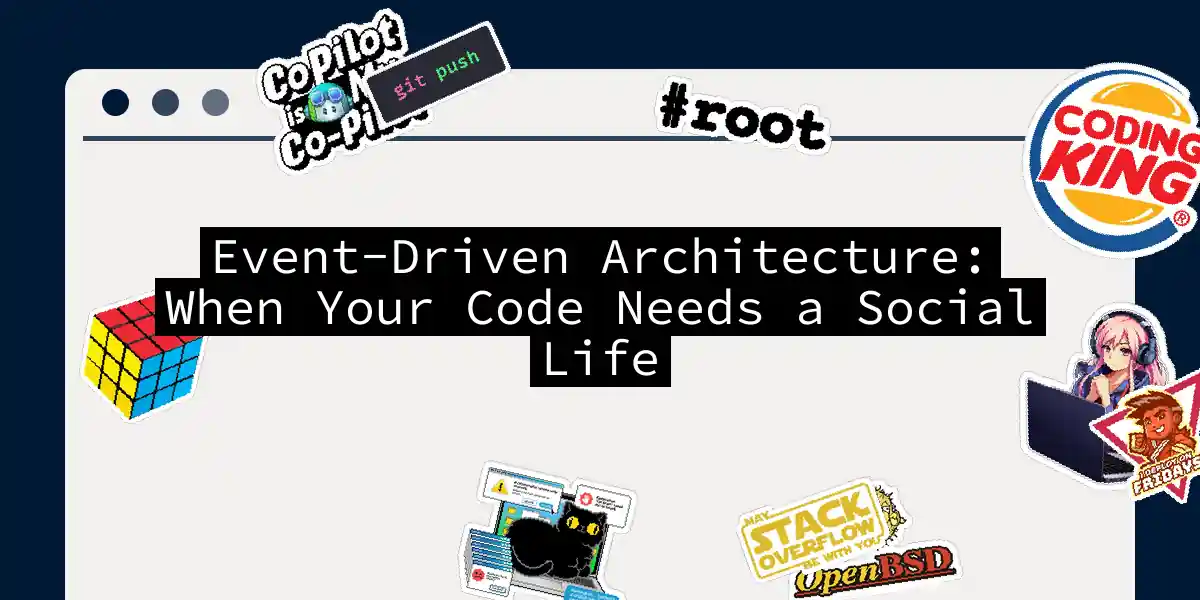Picture this: your monolithic application is that awkward friend who shows up to a party and starts reciting SQL queries. Event-driven architecture (EDA) is the life of the software soiree - it knows how to mingle, react to stimuli, and keeps conversations flowing without awkward silences. Let’s explore how to make your codebase the charismatic extrovert everyone wants to hang with.
The Nuts and Bolts of Event-Driven Flirting
At its core, EDA is about components whispering sweet nothings to each other through events. Let’s break down the key players: Event Producers (The Chatty Cathys):
- Microservices that shout “HEY LOOK WHAT I DID!” into the void
- IoT devices reporting their existential crises (“Temperature changed! Am I still relevant?”)
- User interfaces throwing shade after button clicks Event Bus (The Gossip Network):
Event Consumers (The Eavesdroppers):
- Services that perk up when they hear their favorite gossip
- Serverless functions that spring into action like over-caffeinated interns
- Legacy systems pretending they understand modern events
Pattern Party: Top 3 Dance Moves in EDA
1. Event Sourcing: The Memory Hoarder
Imagine if your application never forgot anything - like that friend who remembers your embarrassing Myspace photos. Event sourcing captures every state change as immutable events .
public class AccountOpenedEvent extends Event {
private UUID accountId;
private BigDecimal initialBalance;
// ... constructor and getters
}
public class MoneyDepositedEvent extends Event {
private UUID accountId;
private BigDecimal amount;
// ... constructor and getters
}
To rebuild current state:
Initial State (€0)
→ AccountOpenedEvent (€100)
→ MoneyDepositedEvent (€150)
→ MoneyWithdrawnEvent (€120)
2. CQRS: The Split Personality
Command Query Responsibility Segregation (CQRS) is like having separate cooks and waiters in a restaurant:
| Aspect | Command Side | Query Side |
|---|---|---|
| Purpose | Write operations | Read operations |
| Data Model | Normalized | Denormalized |
| Performance | Optimized for writes | Optimized for reads |
3. The Saga Pattern: Distributed Drama Queen
Long-running transactions that might fail? Sagas handle them like a soap opera script:
Java Implementation: Let’s Build a Social Network
Step 1: Create our event bus heartthrob
public class EventDispatcher {
private Map<Class<? extends Event>, List<EventHandler<?>>> handlers = new HashMap<>();
public <E extends Event> void registerHandler(Class<E> eventType, EventHandler<E> handler) {
handlers.computeIfAbsent(eventType, k -> new ArrayList<>()).add(handler);
}
public <E extends Event> void dispatch(E event) {
handlers.getOrDefault(event.getClass(), Collections.emptyList())
.forEach(handler -> ((EventHandler<E>) handler).handle(event));
}
}
Step 2: Make some event handlers that actually listen
public class UserNotificationHandler implements EventHandler<UserRegisteredEvent> {
public void handle(UserRegisteredEvent event) {
System.out.println("Sending welcome email to: " + event.getUser().getEmail());
// Actual email sending logic here
}
}
public class AnalyticsHandler implements EventHandler<UserRegisteredEvent> {
public void handle(UserRegisteredEvent event) {
analyticsService.track("USER_REGISTERED", event.getUser());
// Bonus: Track how long until they abandon their cart
}
}
Step 3: Let’s make some magic happen
public static void main(String[] args) {
EventDispatcher dispatcher = new EventDispatcher();
dispatcher.registerHandler(UserRegisteredEvent.class, new UserNotificationHandler());
dispatcher.registerHandler(UserRegisteredEvent.class, new AnalyticsHandler());
User newUser = new User("coolDev42", "[email protected]");
dispatcher.dispatch(new UserRegisteredEvent(newUser));
}
Pro Tip: Want to look extra fancy at the architecture meetup? Add retry logic with exponential backoff for your event handlers - it’s like giving your code emotional resilience!
Common Pitfalls (Or How to Avoid Being That Guy)
- Event Spaghetti: Without proper schemas, your events become Rorschach tests that every service interprets differently. Use Avro or Protobuf for contracts .
- Over-Eventing: Not every state change needs an event. Your login service shouldn’t emit “UserBreathedEvent”.
- Debugging Nightmares: Implement distributed tracing from day one. You’ll thank me when tracking that phantom event that only happens during full moons.
Final Thoughts: Why Your Code Deserves This
Event-driven architecture isn’t just a pattern - it’s a lifestyle choice for your systems.
